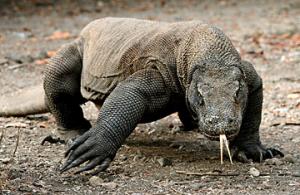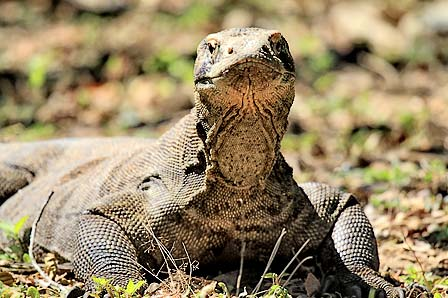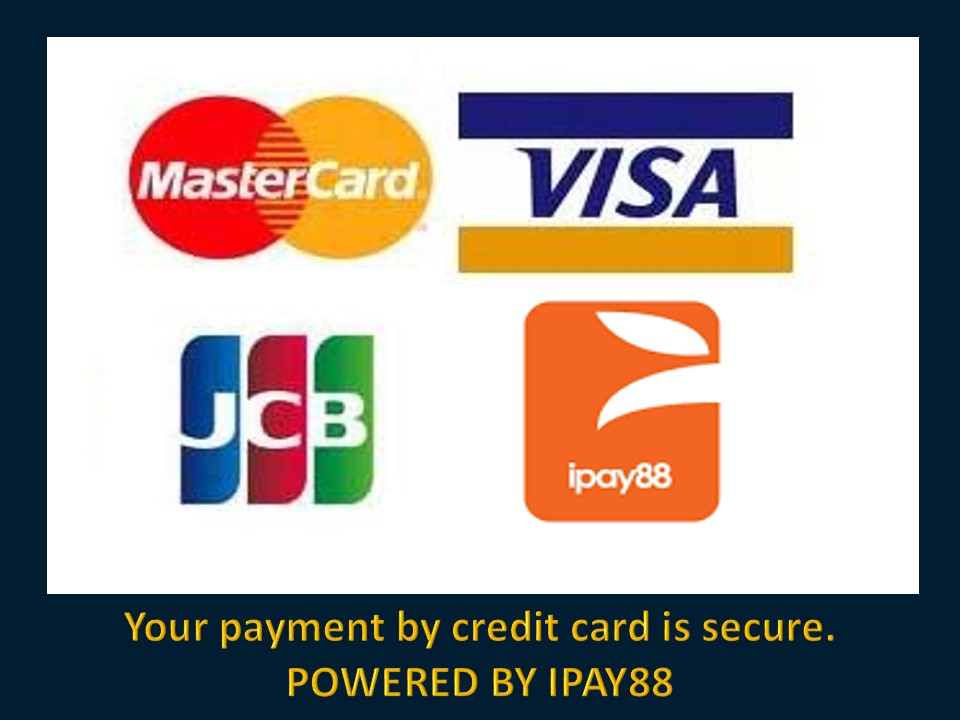18 Maret 2024 13:53:00 / / Hits : 11481 / Posted by Administrator

Komodo National Park: Into The Heart of The Dragons
http://www.indonesia.travel/en/destination/106/komodo-national-park
Overview
Real dragons spurt no fire, have no need to fly and cast no magic spells. And still, one look from them might render you speechless. These komodos, the real life dragons, are a sight indeed. Gigantic, the lizard-like creatures are about two or three meters in length. They can easily weigh about 165 kilograms.  Despite of their sheer size and appearance, they are not active hunters. What makes them intimidating is the fact that they are a patient predator. In the wild, they stalk a victim, usually a weak or injured one. One bite and that’s what it usually takes. After following the victim for a while, sometimes up to several days’ time, the komodos will devour the dying prey.
Despite of their sheer size and appearance, they are not active hunters. What makes them intimidating is the fact that they are a patient predator. In the wild, they stalk a victim, usually a weak or injured one. One bite and that’s what it usually takes. After following the victim for a while, sometimes up to several days’ time, the komodos will devour the dying prey.
Konodo Dragon
The Komodo Dragon (Varanus komodoensis) is an endangered species which can only be found in the Komodo National Park (KNP) in East Nusa Tenggara (NTT). Because of the unique and rare nature of this animal, KNP was declared a World Heritage Site by UNESCO in 1986.
The park includes three major islands, Komodo, Rinca and Padar, and numerous smaller islands together totaling 603 km2 of land. The total size of Komodo National Park is presently 1,817 km2. Proposed extensions of 25 km2 of land (Banta Island) and 479 km2 of marine waters would bring the total surface area up to 2,321 km2.At least 2500 Komodos live in this area. Large dragons are usually three meters long and weigh up to 90 kg. Their habitat has beautiful panoramic views of savannas, rain forests, white beaches, beautiful corals, and clean blue seas. In this area, you can also find horses, wild buffalo, deer, wild boar, snakes, monkeys, and various types of birds.
KNP has a rich and amazing underwater sea biotica. Divers claim that Komodo waters are one of the best diving sites in the world. It has fascinating underwater scenery. You can find 385 species of beautiful corals, mangrove forests, and seaweeds as a home for thousands of fish species, 70 types of sponges, 10 types of dolphins, 6 types of whales, green turtles and various types of sharks and stingrays.
Or you can do some diving activities in Komodo Island. Go this link if you want to see more information about it.
Watch the video about Komodo and Labuan Bajo:
See on The Map
To Stay
Similar with those available in Loh Liang (Komodo Island), Loh Buaya (Rinca Island) also has simple guest houses offering few rooms. A luxurious hotel with limited capacity is currently being built in Loh Liang. Most tourists visiting Rinca Island don’t stay overnight (they come from Labuan Bajo and stay in the hotels in Labuan), while those coming to Komodo Island usually stay in their rented motorboats. Nearly all motorboats have cabins and bed rooms. Large motorboats usually have good bed rooms.
Ranger’s Houses - Komodo Island
The new renovated ranger’s houses in eco style accommodation, with modern facilities featuring with private bathroom, limited electric power supply, dining. Only few step to the beach of Lohliang. Ranger’s houses becomes an alternative accommodation offer to visitors whom for some reasons are not able to sleep on boat.
Puri Komodo Resort - Batu Gosok
Sets on the northwest tip of Flores island of Indonesia, this location well known with Batu Gosok, secluded peninsula. 250.000 square meters of land hideaway guaranteed to thrill snorkelers, divers and adventurers. A magnificent secluded cove with over 1.000 meters of white sandy beach and a wooden jetty protruding 450 meters into the coral rich turquoise waters. Opulent sea gardens in colors of purple, yellow, blue and fuchsia blend with brightly colored tropical fish drifting aimlessly amongst the coral.
Bajo Komodo Eco Lodge
Has developed environmentally friendly buildings with the use of solar power for hot water, an extensive rain water storage system, and the use of a biological sewage treatment plant where all waste water is returned to the gardens through irrigation. The Bajo Eco Lodge is under control of Iniradef non profit organization where to participate in developing the human resources on the area and also building the natural environment conservation. This program have fully accepted by locals.
Boat Accommodation from Labuan Bajo
Simple boat sleep on the deck with set mattresses, fit for a small group up to 4 peoples only, meals freshly cooked on board, mineral bottled water supplied, simple toilet.
Boat Accommodation depart from Bima
Larger boat with cabin, dining facilities and standard safety equipment available for those who are travel to Komodo via Bima. Although it takes you over 7 hours on water - the facilities promises on the boat better enough compare to those who are start from from Labuan Bajo.
Tips
Komodo Dragon
Don’t walk alone. It is best to walk around with a ranger or guide.Don’t disturb or feed komodos. Despite slow and lazy movement, this animal can suddenly turn aggresive and move fast.When trekking, please take a stick with you. Komodos are usually afraid when threatened with a stick.Please wear shoes. Komodo, Rinca, and Padar islands have 12 types of snakes and three of them are poisonous, namely green snakes living on trees, cobras and russel’s viper who live on the ground in holes on the savannas.Women having their menstruation must report to a guide or ranger for special attention. Komodos have a very strong sense of smell and may turn agresive when they smell blood.Please bring along your insect repellant because this area has many mosquitoes who’ll be excited at the prospects of having fresh blood.Most lands on Komodo and Rinca islands are savannas which are prone to fire during the dry season so smoking and making fires are prohibited.
Flores portFor more information please contact:
Komodo Marine National Park Office
Jl. Kasimo Labuan Bajo
West Flores, East Nusa Tenggara 86445
Ph. +62 385 41004
Fax. +62 385 41006
e-mail: tnkomodo@indosat.org
www.komodonationalpark.org
PT Putri Naga Komodo
Bali Branch
Jl. Pengembak No.2 Sanur 80228, Bali
T: +62 381 780 2408
F: +62 361 747 4398
e-mail: info@putrikomodo.com
www.gokomodo.org
Labuan Bajo
Gg.Masjid, Kampung Cempa. Labuan Bajo, 86554 West Manggarai. East Nusa Tenggara.
T: +62 385 41448
F: +62 385 41225
www.floreskomodo.com
www.gokomodo.org
To Buy
At the reception in Loh Buaya and Loh Liang, there are souvenir shops selling t-shirts with komodo pictures on them and wooden komodo statues. There’s not yet a shop selling a t-shirt saying, "I went to see the Komodo Dragons and all I got is this lousy T-shirt." So that’s a potential market for you.
Get Around
Your feet will be your trusted companion on this island. Good thing most people never leave home without them. When you wish to see these animals in their natural habitat, you have to walk to the hills nearby (paths have been designated). On Komodo Island, you have to climb Mount Ara (538 meters above sea level) for three to four hours. On Rinca island, you have to trek for about one and a half hours. If you are lucky, you can see Komodos attacking prey, fighting, or even employing their mojoes along the way, as illustrated by this picture on the left. If that’s too wild for you, you can try to spot a group of deers, buffaloes or wild horses.
Get There
By daily flights from: Bali - Labuan Bajo/Komodo Airport - Bali (each 1.5 hours)
Everyday, there are two to three flights from Bali to Labuan Bajo by Transnusa, IAT (Indonesia Air Transport), and Merpati. In addition, there is a twice a week flight from Kupang. Inter-island motorboats from Sape in West Nusa Tenggara are also available everyday (when the weather permits), and the Pelni ship from Bali and Lombok makes a stop over here every two weeks.
Land transportation from the East (Flores mainland e.g., Ruteng, Bajawa, Ende and Maumere) is also available. If you are interested in making a long trip in Flores, you can start from Maumere to the west i.e., to Moni, Kelimutu, Ende, Bena, Bajawa, Ruteng and lastly Labuan Bajo (Komodo) or vice versa.
The site www.floreskomodo.com offers more detailed information on how to reach the Flores areas.
To Eat
In Loh Liang, the KNP management (PT Putri Naga Komodo) owns a restaurant. No restaurant is available in Rinca Island, though. There is only one kiosk selling drinks and snacks. If you stay in a guest house, you will have food available with your stay. If you take a rented motorboat, your rental usually includes meals (but you have to confirm it when negotiating the rental price).
To Do
You can see and do many things here. It is amazing to see Komodo dragons up close in their native habitat. On Rinca Island, you can see Komodos lying down outside the homes of national park rangers, or "parking" near the officials’ homes. Previously, to find one, you had to “offer” a goat to attract the Komodo, but now this practice is no longer allowed.
If you don’t see a dragon, Rinca and Komodo have beautiful sceneries with white beaches, mangroves, savannas and blue waters. During the dry season, these savannas and hills have dried grasses.
You can also egage in other activities such as diving and snorkeling. You can take a cruise ship or fishermen’s boat in the persuit of these activities. There are diving points highly recommended to visit which include Merah Beach, and Batu Bolong and Tatawa islands. If you want to see thousands of bats, you can stay overnight in a motorboat on Kalong Island waters (near Rinca Island).
If you’re more interested in studying the nature, below’s the description of them in more technical terms, so to speak.
TERRESTRIAL FAUNA
The terrestrial fauna is of rather poor diversity in comparison to the marine fauna. The number of terrestrial animal species found in the Park is not high, but the area is important from a conservation perspective as some species are endemic.. Many of the mammals are Asiatic in origin (e.g., deer, pig, macaques, civet). Several of the reptiles and birds are Australian in origin. These include the orange-footed scrubfowls, the lesser sulpher-crested cockatoos and the nosy friarbirds.
Reptiles: Other than the Komodo Dragons, twelve terrestrial snake species are found on the island. including the cobra (Naja naja sputatrix), Russel’s pit viper (Vipera russeli), and the green tree vipers (Trimeresurus albolabris). Lizards include 9 skink species (Scinidae), geckos (Gekkonidae), limbless lizards (Dibamidae), and, of course, the monitor lizards (Varanidae). Frogs include the Asian Bullfrog (Kaloula baleata), Oreophyne jeffersoniana and Oreophyne darewskyi. They are typically found at higher, moister altitudes.
Mammals: Mammals include the Timor deer (Cervus timorensis), the main prey of the Komodo dragon, horses (Equus sp.), water buffalo (Bubalus bubalis), wild boar (Sus scrofa vittatus), long-tailed macaques (Macaca fascicularis), palm civets (Paradoxurus hermaphroditus lehmanni), the endemic Rinca rat (Rattus rintjanus), and fruit bats. One can also find goats, dogs and domestic cats.
Birds: One of the main bird species is the orange-footed scrub fowl (Megapodius reinwardti), a ground dwelling bird. In areas of savanna, 27 species were observed. Geopelia striata and Streptopelia chinensis were the most common species. In mixed deciduous habitat, 28 bird species were observed, and Philemon buceroides, Ducula aenea, and Zosterops chloris were the most common.
MARINE PHYSICAL ENVIRONMENT
The marine area constitutes 67% of the Park. The open waters in the Park are between 100 and 200 m deep. The straits between Rinca and Flores and between Padar and Rinca, are relatively shallow (30 to 70 m deep), with strong tidal currents. The combination of strong currents, coral reefs and islets make navigation around the islands in Komodo National Park difficult and dangerous. Sheltered deep anchorage is available at the bay of Loh Liang on Komodo’s east coast, the South East coast of Padar, and the bays of Loh Kima and Loh Dasami on Rinca.
In the North of the Park water temperature ranges between 25 – 29°C. In the middle, the temperature ranges between 24 and 28°C. The temperatures are lowest in the South, ranging from 22 – 28°C. Water salinity is about 34 ppt and the water is quite clear, although the waters closer to the islands are relatively more turbid.
MARINE ECOSYSTEMS
Indonesia is the only equatorial region in the world where there is an exchange of marine flora and fauna between the Indian and Pacific oceans. Passages in Nusa Tenggara (formerly the Lesser Sunda Islands) between the Sunda and Sahul shelves allow movement between the Pacific and Indian oceans. The three main ecosystems in Komodo National Park are seagrass beds, coral reefs, and mangrove forests. The Park is probably a regular cetacean migration route.
Komodo Underwater
MARINE FLORA
The three major coastal marine plants are algae, seagrasses and mangrove trees. Algae are primitive plants, which do not have true roots, leaves or stems. An important reef-building algae is the red coralline algae, which actually secretes a hard limestone skeleton that can encrust and cement dead coral together. Seagrasses are modern plants that produce flowers, fruits and seeds for reproduction. As their name suggests, they generally look like large blades of grass growing underwater in sand near the shore. Thallasia sp. and Zastera spp. are the common species found in the Park. Mangroves trees can live in salty soil or water, and are found throughout the Park. An assessment of mangrove resources identified at least 19 species of true mangroves and several more species of mangrove associates within the Park’s borders.
MARINE FAUNA
Komodo National Park includes one of the world’s richest marine environments. It consists of forams, cnidaria (includes over 260 species of reef building coral), sponges (70 species), ascidians, marine worms, mollusks, echinoderms, crustaceans, cartilaginous and bony fishes (over 1,000 species), marine reptiles, and marine mammals (dolphins, whales, and dugongs). Some notable species with high commercial value include sea cucumbers (Holothuria), Napoleon wrasse (Cheilinus undulatus), and groupers.
MORE DETAILS AND RESERVATION :
PT. BOROBUDUR DESTINASI UTAMA
Nologaten RT 01/RW 04 No 40, Catur Tunggal, Depok, Sleman, Yogyakarta 55281
Phone:+62 274 485672
Mobile: +628112640967 or +6281904130290
Whatsapp: +628112640967
Email: borobudursunrise.net@gmail.com Or eko.wijoyanto@gmail.com
http://www.borobudursunrise.net/ OR http://merapiadventure.com/
Tags : komodo, komodo island
NIB : 0302240041553
Jl. Temulawak, RT 01/RW 04 No 40 Nologaten, Catur Tunggal, Depok, Sleman, Yogyakarta 55281
Phone
0274485672
Mobile
08112640967
Email :
borobudursunrise.net@gmail.com
| ONLINE SUPPORTS : |
 |
| WE ACCEPT |
 |
 |
|
Exchange Rate : |
Jl. Temulawak, RT 01/RW 04 No 40 Nologaten, Catur Tunggal, Depok, Sleman, Yogyakarta 55281
Phone
0274485672
Mobile
+628112640967
WhatsApp
+628112640967
Telegram
+628112640967
Line
borobudursunrise
![]() BANK MANDIRI
BANK MANDIRI
137001421XXXX
PT. BOROBUDUR DESTINASI UTAMA, Swift Code : BMRIIDJA
![]() Transfer Wise
Transfer Wise
https://wise.com/
https://wise.com/
![]() CREDIT CARD
CREDIT CARD
POWERED BY IPAY88
POWERED BY IPAY88